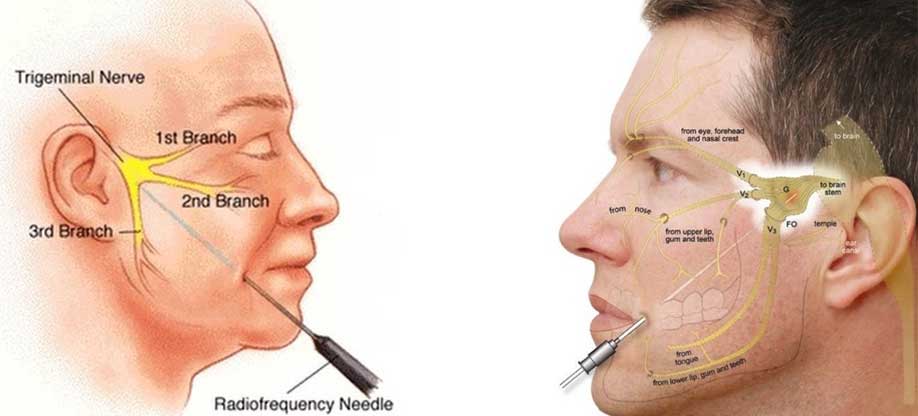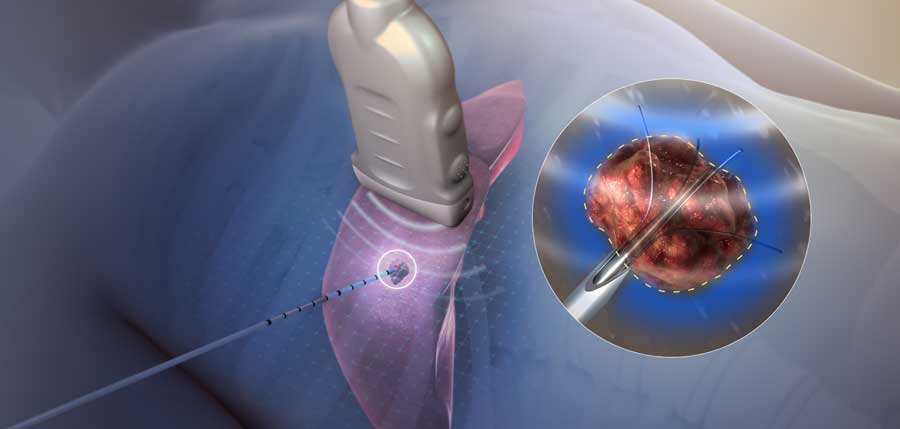Radiofrequency Ablation for Trigeminal Neuralgia

A very safe and effective treatment method for Trigeminal Neuralgia (TN) is Radiofrequency Ablation (RFA). Due to its extremely low risk, RFA for TN is very favorable for elderly and frail patients as well as patients with other comorbidities for whom the open neurosurgical
therapy is not considered feasible. This minimally invasive treatment for Trigeminal Neuralgia is best suited for patients having pain in a localized area of the face.
This specialized procedure is performed under local anaesthesia as the patient needs to be fully awake to confirm exact site of pain during the procedure. The expert Interventional Radiologist inserts the RFA needle by the corner of the mouth and guides it to the Trigeminal Nerve that is situated at the base of the skull. After X-ray confirmation, the patient is woken up and the nerve is incited. Once confirmed by the patient that they are feeling the stimulation in the same area that they experience pain, the needle is verified to be in the correct position. After putting the patient under minimal sedation, radiofrequency heat is used to slightly damage (injure) the nerve just so enough to cause facial numbness and tingling and take the pain away.
The procedure carries a very high success rate of 90-95% and can be repeated if significant pain returns.
Microwave Ablation (MWA) Thyroid Nodule

Microwave Ablation of Thyroid Nodule is a newly developed minimally-invasive treatment method, which carries a very low risk and side-effects profile and has been proven to achieve superior cosmetic and symptomatic results. Microwave Ablation of Thyroid Nodule aims at destroying only the thyroid nodule by using the heat generated through electromagnetic waves, without harming or damaging the surrounding tissue.
After confirming the benign nature of thyroid nodule, Microwave Ablation of the thyroid nodule is performed by an expert Interventional Radiologist usually with local/regional anesthesia. Under appropriate imaging (ultrasound) guidance, the microwave antenna needle is positioned into the thyroid nodule to be treated. After verifying proper placement, the microwave antenna is activated to heat and destroy the thyroid nodule. The ablation needle may need to be repositioned to ensure complete ablation of the thyroid nodule.
The main advantage of Microwave Ablation of Thyroid Nodule is that there is no need for the patient to be admitted. This procedure also has a shorter recovery period as compared to the surgery and achieves superior cosmetic outcome. The success rate of this procedure is also quite high.
Radiofrequency Ablation (RFA) for Osteoid Osteoma
Radiofrequency Ablation of Osteoid Osteoma is a minimally-invasive pin-hole procedure that carries a high success rate of close to 100% and is considered the Method of Choice for the treatment of Osteoid Osteoma. Radiofrequency Ablation for Osteoid Osteoma aims at destroying the Osteoma (benign bone growth) through the heat generated by Radiofrequency energy (waves). It causes no damage to the vital structures and does not cause any significant structural (bony) weakness. It takes approximately 60-90 minutes for an expert Interventional Radiologist to perform this procedure and it is usually performed with the patient under general anesthesia.
After confirming the location of the Osteoid Osteoma under CT Guidance, a cannula (a very thin hollow tube) is advanced to the lesion under fluoroscopy. After verifying correct positioning of the cannula, Radiofrequency probe (electrode) is then placed into the tumour through the cannula. The Radiofrequency probe is then heated to 85-90 ℃ to destroy the bone tumour. Upon completion of the procedure, the Radiofrequency probe and cannula are removed and a sterile dressing is applied to the skin entry site incision (small cut).
The patient is usually able to go home the same day and the pain relief is generally felt within 2-3 days. The patient can resume normal daily activities within the first week.
Microwave Ablation (MWA) Uterine Fibroid
Microwave Ablation for Uterine Fibroid is a recently developed minimally-invasive, very effective and safe treatment method. This method involves damaging only the fibroid tissue with the help of heat generated by electromagnetic waves, causing no or very minimal damage to the surrounding tissue.
This procedure can be done with the patient under conscious sedation where the patient is kept awake and relaxed and given anesthesia only to block the pain. Using ultrasonography guidance, after confirming the proper position of the uterine fibroid, the Microwave antenna is advanced into uterus and placed in the center of the fibroid. Once proper positioning of the Microwave antenna is confirmed through imaging guidance, the Microwave antenna is activated to generate heat and destroy the fibroid tissue. The Microwave antenna may need to be repositioned and the ablation procedure repeated in order to ensure that the fibroid is satisfactorily ablated. Once the procedure is complete, the Microwave antenna is pulled back and the patient is kept under observation.
This procedure carries a low side-effect profile and has a short recovery time. Also, the effectiveness and success rate of Microwave Ablation of uterine fibroids is quite high.






